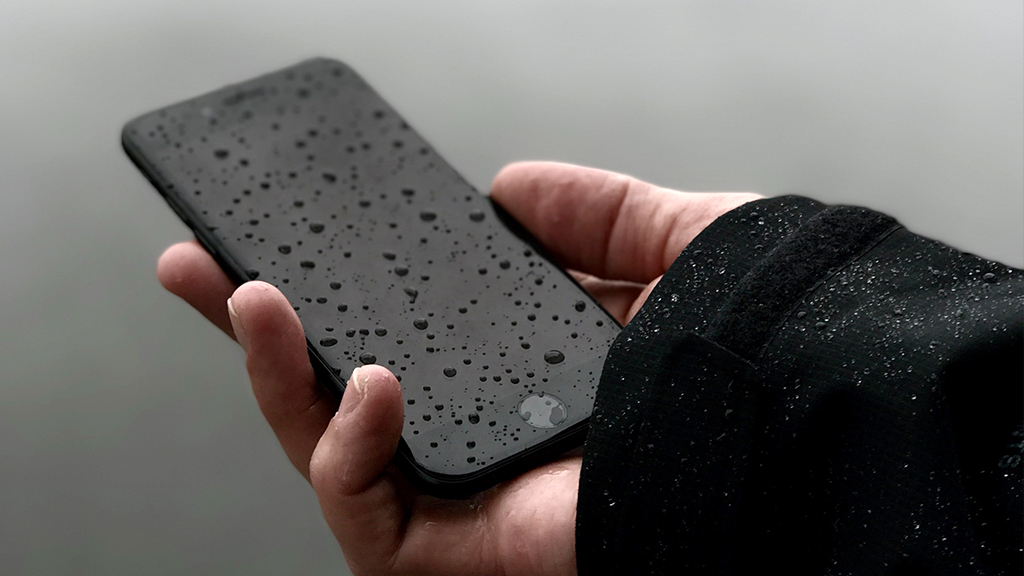⚡ Fast fix
- Shut it down fast—water and power don’t mix.
- Remove the case, SIM card, and accessories to let air circulate.
- Dry with silica gel—not rice and give it time to fully dry.
- Still no luck? Visit your nearest uBreakiFix® by Asurion store for help.
From the beach to the boat, wherever we go to enjoy warmer weather, our phones are usually right along for the fun—and keeping them above water can be a challenging task. According to 2023 Asurion claims data, more phone repair claims are filed for liquid damage between June and August than any other time of the year.
So, what is the best way to protect your phone from liquid damage? Asurion Experts are asked this question often while helping our 300 million (and counting) customers with all of their tech care needs. Their advice: Invest in a waterproof pouch. While some of the newest phones are considered “waterproof,” they’ll only be protected if submerged for a set period of time—to learn more, check out our guide to waterproof vs water-resistant phones. Waterproof phone pouches, like those made by CaliCase® or JOTO®, will help to keep your phone afloat.
In case your device does take a plunge, here are tips for getting water out of your phone that you'll need to know.
How to get water out of your phone
Here's what to do if you drop your phone in water or get it wet:
- Remove it from the liquid immediately. The longer it stays there, the more liquid will seep into various inlets.
- Turn the phone off and leave it off.
- Remove the protective case.
- If possible, open the back and remove the battery, SIM card, and microSD card (if you have one). Not sure how to remove the SIM card? Check out our guide for iPhone and Android.
- Use a cloth or paper towel to dab your phone dry. Do not rub the phone, as doing so could accidentally push liquid into the phone’s more sensitive parts. If the phone was completely submerged, you might try (very) gently vacuuming around the phone’s creases and openings to suck more water out.
- Resist the urge to bake your phone in the sun. Keep it in a cool, dry place.
- You’ve probably heard the suggestion to put your phone in rice if it gets wet, but we do not recommend this method. Instead, try silica gel packets, like the ones that often come with new products such as a pair of shoes, as they’ve proven to be much more effective. Fill a plastic zip-top bag with silica gel packets and bury the phone in the bag. Leave your phone in the bag for 24–48 hours.
- After you’ve allowed your phone to fully dry, switch it on. If it doesn’t turn on right away, charge it fully and try again.
If your phone turns back on, great! Still, keep an eye on it over the next week or so, as sometimes certain features won’t work the way they used to.
If you've tried these steps and still need a little help, we're right around the corner. Schedule a repair at the nearest uBreakiFix® by Asurion store and our certified experts can get your device back up and running as soon as the same day.
How can you tell if your phone has water damage?
There are a few signs that can confirm water damage to your device:
- Look for the visual presence of water or evaporation (or dried water markings) behind the screen.
- Check for corrosion marks visible at ports.
- Check the Discolored Liquid Damage Indicator (LDI). The LDI is typically located in the headphone jack, battery compartment, or SIM tray slot. If your phone has water damage, the LDI will appear red or maroon.
Does rice fix water-damaged phones?
According to Asurion Experts, putting your water-exposed device in rice may absorb some moisture. However, it may also cause other issues for your phone, such as an introduction of dust and dry starch—a rice byproduct—into your phone's cracks and crevices. Rice could also potentially become lodged in your phone's charging port or headphone jack, which can be extremely difficult to dislodge as the rice swells when exposed to liquid.
Can you blow-dry a water-damaged phone?
Blow-drying your phone when it's exposed to water is not recommended. While it might remove some of the surface moisture, it will do very little to remove the moisture from inside your device and the heat could do irreparable damage to your phone's internal components.
How do you remove water from a charging port?
Here are the steps to take to remove water from a phone's charging port:
- Turn off the device.
- If your phone is in a case, take it off.
- Remove the battery (if you can).
- Wipe down the device with a dry, absorbent towel.
- Blow away the excess fluid carefully with compressed air or by carefully blowing on it.
- Let it sit and dry out, with open ports facing down.
How do you get water out of your phone speakers?
Try these tips to get water out of your iPhone or Android phone speakers:
- Take a cotton swab and gently swab the area around the speakers.
- Turn the device off and place it in an upright position to dry out, with the speakers facing downward. Doing so will encourage excess water to come out.
Does Asurion cover water damage?
While dropping your smartphone into liquid typically voids the manufacturer’s warranty automatically—many phones have indicators that change colors when wet—that isn’t the case when it comes to your smartphone insurance policy. If your phone is covered, you can start a claim at asurion.com at any time.
